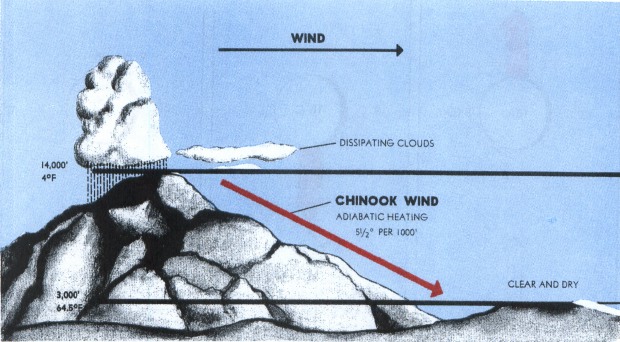Aviation Weather
full text of the classic FAA guide
CHANGES WITHIN UPWARD AND DOWNWARD MOVING AIR
Anytime air moves upward, it expands because of decreasing atmospheric pressure as shown in figure 40. Conversely, downward moving air is compressed by increasing pressure. But as pressure and volume change, temperature also changes.

When air expands, it cools; and when compressed, it warms. These changes are adiabatic, meaning that no heat is removed from or added to the air. We frequently use the terms expansional or adiabatic cooling and compressional or adiabatic heating. The adiabatic rate of change of temperature is virtually fixed in unsaturated air but varies in saturated air.
UNSATURATED AIR
Unsaturated air moving upward and downward cools and warms at about 3.0° C (5.4° F) per 1,000 feet. This rate is the “dry adiabatic rate of temperature change” and is independent of the temperature of the mass of air through which the vertical movements occur. Figure 41 illustrates a “Chinook Wind”—an excellent example of dry adiabatic warming.

SATURATED AIR
Condensation occurs when saturated air moves upward. Latent heat released through condensation (chapter 5) partially offsets the expansional cooling. Therefore, the saturated adiabatic rate of cooling is slower than the dry adiabatic rate. The saturated rate depends on saturation temperature or dew point of the air. Condensation of copious moisture in saturated warm air releases more latent heat to offset expansional cooling than does the scant moisture in saturated cold air. Therefore, the saturated adiabatic rate of cooling is less in warm air than in cold air.
When saturated air moves downward, it heats at the same rate as it cools on ascent provided liquid water evaporates rapidly enough to maintain saturation. Minute water droplets evaporate at virtually this rate. Larger drops evaporate more slowly and complicate the moist adiabatic process in downward moving air.
ADIABATIC COOLING AND VERTICAL AIR MOVEMENT
If we force a sample of air upward into the atmosphere, we must consider two possibilities:
The air may become colder than the surrounding air, or
Even though it cools, the air may remain warmer than the surrounding air.
If the upward moving air becomes colder than surrounding air, it sinks; but if it remains warmer, it is accelerated upward as a convective current. Whether it sinks or rises depends on the ambient or existing temperature lapse rate (chapter 2).
Do not confuse existing lapse rate with adiabatic rates of cooling in vertically moving air.* The difference between the existing lapse rate of a given mass of air and the adiabatic rates of cooling in upward moving air determines if the air is stable or unstable.
* Sometimes you will hear the dry and moist adiabatic rates of cooling called the dry adiabatic lapse rate and the moist adiabatic lapse rate. In this book, lapse rate refers exclusively to the existing, or actual, decrease of temperature with height in a real atmosphere. The dry or moist adiabatic lapse rate signifies a prescribed rate of expansional cooling or compressional heating. An adiabatic lapse rate becomes real only when it becomes a condition brought about by vertically moving air.
Table of Contents
Previous Section: Stable and Unstable Air
Next Section: Stability and Instability
A PDF version of this book is available here. You may be able to buy a printed copy of the book from amazon.com.
